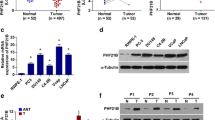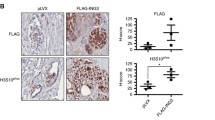Abstract
The objectives of this study were to examine the expression levels of Homeobox A10 (HoxA10) in prostate cancer cells and to study the molecular mechanism of HoxA10-mediated regulation of prostate cancer cell growth and development. We investigated the effect of HoxA10 on cell proliferation by stably overexpressing or silencing HoxA10 in prostate cancer PC-3 cell line using lentiviral vectors. Quantitative real-time PCR and western blotting analysis were used to compare the expressions of HoxA10 in prostate cancer cell lines and normal prostate epithelium. Cancer cell proliferation was examined by MTT assay and colony formation assay. The levels of HoxA10 expression were significantly increased in prostate cancer cell lines and tissues compared to those in normal prostate epithelium. Overexpression of HoxA10 in PC-3 cells induced significant cancer cell proliferation, whereas silencing of HoxA10 expression by RNAi resulted in decreased proliferation rates. HoxA10 was highly expressed in prostate cancer cells and tissues, suggesting its functional involvement in cancer cell proliferation. We successfully overexpressed or silenced HoxA10 in prostate cancer PC-3 cell line and discovered that the levels of HoxA10 directly correlate with cancer cell proliferation. These findings contribute to a better understanding of the regulatory mechanism of HoxA10 in prostate cancer.



Similar content being viewed by others
References
Shah, N., & Sukumar, S. (2010). The HOX genes and their roles in oncogenesis. Nature Reviews Cancer, 10, 361–371.
Cillo, C., Cantile, M., Faiella, A., et al. (2001). Homeobox genes in normal and malignant cell. Journal of Cellular Physiology, 188(2), 161–169.
Daftary, G. S., & Taylor, H. S. (2004). Pleiotropic effects of HOXA10 on the functional development of peri-implantation endometrium. Molecular Reproduction and Development, 67(1), 8–14.
Kim, J. J., & Fazleabas, A. T. (2004). Uterine receptivity and implantation: The regulation and action of insulin-like growth factor binding protein 1 (IGFBP1), HOXA10 and forkhea transcription factor 1 (FOXO1) in the baboon endometrium. Reproductive Biology and Endocrinology, 16(2), 34–40.
Abem, J., Hamada, J., Takahashi, O., et al. (2006). Disordered expression of HOX gebes in human non small cell cancer. Oncology Reports, 15(4), 797–802.
Plowright, L., Harrington, K. J., Pandha, H. S., et al. (2009). HOX transcription factor scare potential therapeutic targets in non small cell lung cancer. British Journal of Cancer, 100(3), 470–475.
Calvo, R., west, J., et al. (2000). Altered HOX and WNT7A expression in human lung cancer. Proceedings of the National Academy of Sciences of the United States of America, 97(23), 12776–12781.
Bjornsson, J. M., Andersson, E., Lundström, P., et al. (2001). Proliferation of primitive myeloid progenitors can be reversibly induced by HOXA10. Blood, 98(12), 3301–3308.
Lim, J. Y., Yoon, S. O., Seol, S. Y., et al. (2013). Overexpression of miR-196b and HOXA10 characterize a poor-prognosis gastric cancer subtype. World Journal of Gastroenterology, 19(41), 7078–7088.
Jiang, Y., Chu, Y., Tang, W., et al. (2013). Transcription factor WT1 and promoter CpG hypomethylation coactivate HOXA10 expression in ovarian cancer. Current Pharmaceutical Design, 20(11), 1647–1654.
Qu, Y., Dang, S., & Hou, P. (2013). Gene methylation in gastric cancer. Clinica Chimica Acta, 23(424), 53–65.
Ferlay, J., Shin, H. R., Bray, F., et al. (2010). Estimates of worldwide burden of cancer in 2008 GLOBOCAN 2008. International Journal of Cancer, 127, 2893–2917.
Waltregny, D., Alami, Y., Clausse, N., et al. (2002). Overexpression of the homeobox gene HOXC8 in human prostate cancer correlates with loss of tumor differentiation. Prostate, 50, 162–169.
Siegel, R., Naishadham, D., & Jemal, A. (2013). Cancer statistics, 2013. CA: A Cancer Journal for Clinicians, 63, 11–30.
Hanahan, D., & Weinberg, R. A. (2000). The hallmarks of cancer. Cell, 100(1), 57–70.
Huggins, C., & Hodges, C. V. (1972). Studies on prostatic cancer. I. The effect of castration, of estrogen and androgen injection on serum phosphatases in metastatic carcinoma of the prostate. CA: A Cancer Journal for Clinicians, 22, 232–240.
Dash, R., Azab, B., Shen, X. N., et al. (2011). Developing an effective gene therapy for prostate cancer: New technologies with potential to translate from the laboratory into the clinic. Discovery medicine, 11(56), 46–56.
Prenzel, N., Fischer, O. M., Streit, S., et al. (2001). The epidermal growth factor receptor family as a central element for cellular signal transduction and diversification. Endocrine-Related Cancer, 8(1), 11–31.
Liu, J., Jones, K. L., Sumer, H., et al. (2009). Stable transgene expression in human embryonic stem cells after simple chemical transfection. Molecular Reproduction and Development, 76(6), 580–586.
Wang, H., Shayakhmetov, D. M., Leege, T., et al. (2005). A capsid-modified helper-dependent adenovirus vector containing the beta-globin locus control region displays a nonrandom integration pattern and allows stable, erythroid-specific gene expression. Journal of Virology, 79(17), 10999–11013.
Soifer, H. S., & Kasahara, N. (2004). Retrotransposon-adenovirus hybrid vectors:efficient delivery and stable integration of transgenes via a two-stage mechanism. Current Gene Therapy, 4(4), 373–384.
Acknowledgment
This study was supported by Science and Technology Planning Project of Guangdong Province, China (01078650166731031); Medical Scientific Research Foundation of Guangdong Province, China (A2011469); and Health Science and Technology Foundation of Guangzhou Municipality, China (201102A213075).
Author information
Authors and Affiliations
Corresponding author
Rights and permissions
About this article
Cite this article
Li, B., Cao, X., Weng, C. et al. HoxA10 Induces Proliferation in Human Prostate Carcinoma PC-3 Cell Line. Cell Biochem Biophys 70, 1363–1368 (2014). https://doi.org/10.1007/s12013-014-0065-7
Published:
Issue Date:
DOI: https://doi.org/10.1007/s12013-014-0065-7




